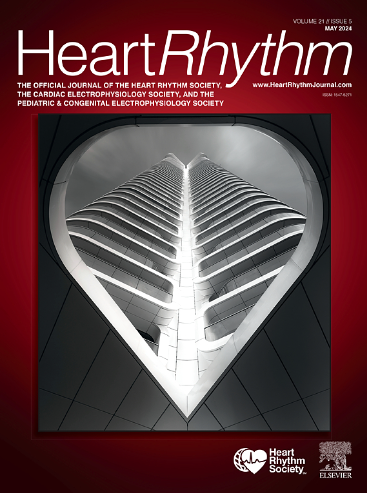Systematic analysis of SCN5A variants associated with inherited cardiac diseases
IF 5.6
2区 医学
Q1 CARDIAC & CARDIOVASCULAR SYSTEMS
引用次数: 0
Abstract
Background
SCN5A variants are associated with a spectrum of cardiac electrical disorders with clear phenotypes. However, they may also be associated with complex phenotypic traits like overlap syndromes or pleiotropy, which have not been systematically described. In addition, the involvement of SCN5A in dilated cardiomyopathies (DCMs) remains controversial.
Objective
We aimed to evaluate the different phenotypes associated with pathogenic (P)/likely pathogenic (LP) SCN5A variants and to determine the prevalence of pleiotropy in a large multicentric cohort of P/LP SCN5A variant carriers.
Methods
The DNA of 13,510 consecutive probands (9960 with cardiomyopathies) was sequenced with a custom panel of genes. Individuals carrying a heterozygous single P/LP SCN5A variant were selected and phenotyped.
Results
The study included 170 P/LP variants found in 495 patients. Of them, 119 (70%) were exclusively associated with a single well-established phenotype: 91 with Brugada syndrome, 15 with type 3 long QT syndrome, 6 with progressive cardiac conduction disease, 4 with multifocal ectopic Purkinje-related premature contractions, and 3 with sick sinus syndrome. Thirty-two variants (19%) were associated with overlap syndromes or pleiotropy. The 19 remaining variants (11%) were associated with atypical or unclear phenotypes. Of those, 8 were carried by 8 patients presenting with DCM with a debatable causative genotype/phenotype link.
Conclusion
Most P/LP SCN5A variants were found in patients with primary electrical disorders, mainly Brugada syndrome. Nearly 20% were associated with overlap syndromes or pleiotropy, underscoring the need for comprehensive phenotypic evaluation. The concept of SCN5A variants causing DCM is extremely rare (8/9960) if not questionable.

系统分析与遗传性心脏病相关的 SCN5A 变异。
背景:SCN5A 变异与一系列表型明确的心电紊乱有关。然而,它们也可能与复杂的表型特征有关,如重叠综合征或多重效应,这些尚未得到系统的描述。此外,SCN5A 在扩张型心肌病(DCM)中的参与仍然存在争议:我们的目的是:(1) 评估与致病性(P)/可能致病性(LP)SCN5A 变异相关的不同表型;(2) 确定 P/LP SCN5A 变异携带者大型多中心队列中多向性的发生率:方法:使用定制的基因面板对 13,510 名连续的原发性患者(其中 9960 人患有心肌病)的 DNA 进行测序。筛选出携带单个 P/LP SCN5A 杂合子变体的个体并进行表型分析:研究包括 495 名患者中发现的 170 个 P/LP 变异。其中,119 个变异(70%)只与一种已确定的表型相关:91例与Brugada综合征有关,15例与3型长QT综合征有关,6例与进行性心脏传导疾病有关,4例与多灶性异位Purkinje相关性早搏有关,3例与病态窦性综合征有关。32个变异体(19%)与重叠综合征和/或多变性有关。其余 19 个变异体(11%)与非典型或不明确的表型有关。在这些变异中,有8个变异由8名出现DCM的患者携带,其致病基因型/表型之间的联系值得商榷:结论:大多数 P/LP SCN5A 变异在原发性心电紊乱患者中发现,主要是 Brugada 综合征。近20%的变异与重叠综合征或多重变异有关,这强调了进行综合表型评估的必要性。SCN5A 变异导致 DCM 的概念即使不存在疑问,也极为罕见(8/9960)。
本文章由计算机程序翻译,如有差异,请以英文原文为准。
求助全文
约1分钟内获得全文
求助全文
来源期刊

Heart rhythm
医学-心血管系统
CiteScore
10.50
自引率
5.50%
发文量
1465
审稿时长
24 days
期刊介绍:
HeartRhythm, the official Journal of the Heart Rhythm Society and the Cardiac Electrophysiology Society, is a unique journal for fundamental discovery and clinical applicability.
HeartRhythm integrates the entire cardiac electrophysiology (EP) community from basic and clinical academic researchers, private practitioners, engineers, allied professionals, industry, and trainees, all of whom are vital and interdependent members of our EP community.
The Heart Rhythm Society is the international leader in science, education, and advocacy for cardiac arrhythmia professionals and patients, and the primary information resource on heart rhythm disorders. Its mission is to improve the care of patients by promoting research, education, and optimal health care policies and standards.
 求助内容:
求助内容: 应助结果提醒方式:
应助结果提醒方式:


